Nursing 7: Analysis of Breast Cancer Impact on Women's Self-Esteem
VerifiedAdded on 2020/04/21
|12
|1771
|99
Report
AI Summary
This report, prepared for Nursing 7, examines the psychological impact of breast cancer and mastectomy on women. It analyzes several research articles that explore the effects of breast cancer diagnosis and treatment, including mastectomy, on women's self-esteem, body image, and overall quality of life. The studies utilize various methodologies, including questionnaires and statistical analysis, to assess patient satisfaction with surgical options like contralateral prophylactic mastectomy (CPM) and the factors influencing these decisions. The research highlights the importance of considering psychological factors, such as fear of recurrence and the availability of reconstruction, in the decision-making process. The report also discusses the impact of hospital IBR volumes on mastectomy rates and the long-term satisfaction of women who underwent CPM. The findings emphasize the need for comprehensive care that addresses both the physical and psychological aspects of breast cancer treatment.
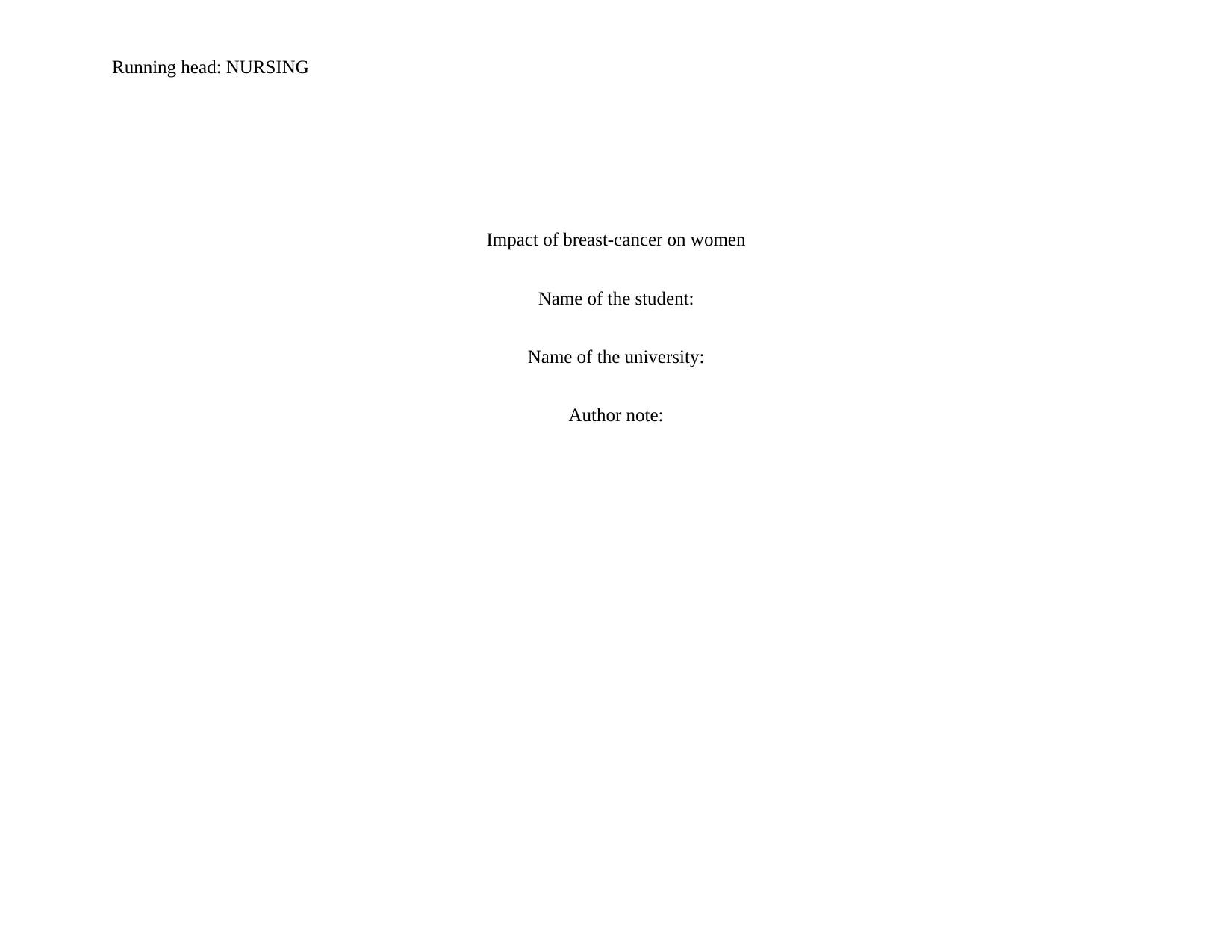
Running head: NURSING
Impact of breast-cancer on women
Name of the student:
Name of the university:
Author note:
Impact of breast-cancer on women
Name of the student:
Name of the university:
Author note:
Paraphrase This Document
Need a fresh take? Get an instant paraphrase of this document with our AI Paraphraser
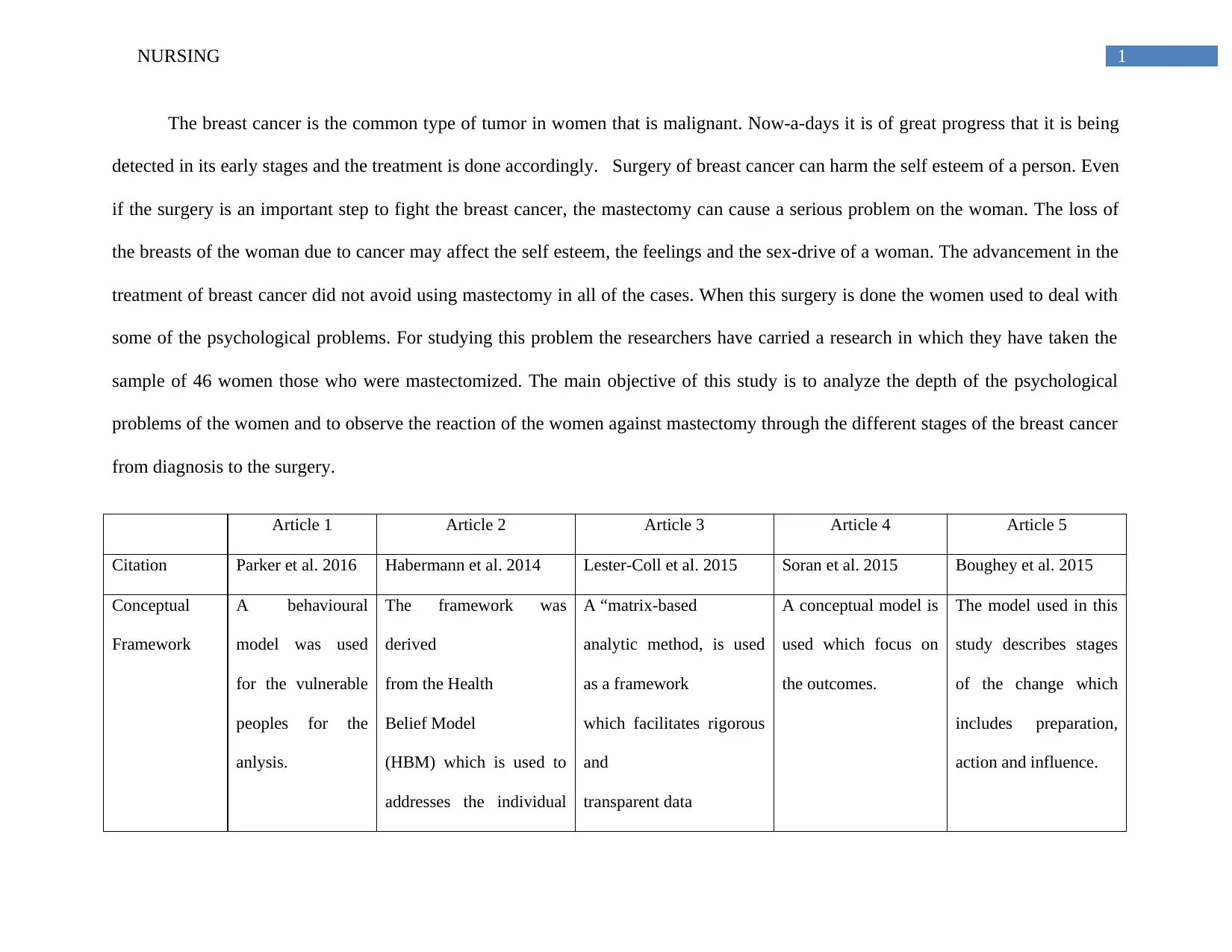
1NURSING
The breast cancer is the common type of tumor in women that is malignant. Now-a-days it is of great progress that it is being
detected in its early stages and the treatment is done accordingly. Surgery of breast cancer can harm the self esteem of a person. Even
if the surgery is an important step to fight the breast cancer, the mastectomy can cause a serious problem on the woman. The loss of
the breasts of the woman due to cancer may affect the self esteem, the feelings and the sex-drive of a woman. The advancement in the
treatment of breast cancer did not avoid using mastectomy in all of the cases. When this surgery is done the women used to deal with
some of the psychological problems. For studying this problem the researchers have carried a research in which they have taken the
sample of 46 women those who were mastectomized. The main objective of this study is to analyze the depth of the psychological
problems of the women and to observe the reaction of the women against mastectomy through the different stages of the breast cancer
from diagnosis to the surgery.
Article 1 Article 2 Article 3 Article 4 Article 5
Citation Parker et al. 2016 Habermann et al. 2014 Lester-Coll et al. 2015 Soran et al. 2015 Boughey et al. 2015
Conceptual
Framework
A behavioural
model was used
for the vulnerable
peoples for the
anlysis.
The framework was
derived
from the Health
Belief Model
(HBM) which is used to
addresses the individual
A “matrix-based
analytic method, is used
as a framework
which facilitates rigorous
and
transparent data
A conceptual model is
used which focus on
the outcomes.
The model used in this
study describes stages
of the change which
includes preparation,
action and influence.
The breast cancer is the common type of tumor in women that is malignant. Now-a-days it is of great progress that it is being
detected in its early stages and the treatment is done accordingly. Surgery of breast cancer can harm the self esteem of a person. Even
if the surgery is an important step to fight the breast cancer, the mastectomy can cause a serious problem on the woman. The loss of
the breasts of the woman due to cancer may affect the self esteem, the feelings and the sex-drive of a woman. The advancement in the
treatment of breast cancer did not avoid using mastectomy in all of the cases. When this surgery is done the women used to deal with
some of the psychological problems. For studying this problem the researchers have carried a research in which they have taken the
sample of 46 women those who were mastectomized. The main objective of this study is to analyze the depth of the psychological
problems of the women and to observe the reaction of the women against mastectomy through the different stages of the breast cancer
from diagnosis to the surgery.
Article 1 Article 2 Article 3 Article 4 Article 5
Citation Parker et al. 2016 Habermann et al. 2014 Lester-Coll et al. 2015 Soran et al. 2015 Boughey et al. 2015
Conceptual
Framework
A behavioural
model was used
for the vulnerable
peoples for the
anlysis.
The framework was
derived
from the Health
Belief Model
(HBM) which is used to
addresses the individual
A “matrix-based
analytic method, is used
as a framework
which facilitates rigorous
and
transparent data
A conceptual model is
used which focus on
the outcomes.
The model used in this
study describes stages
of the change which
includes preparation,
action and influence.
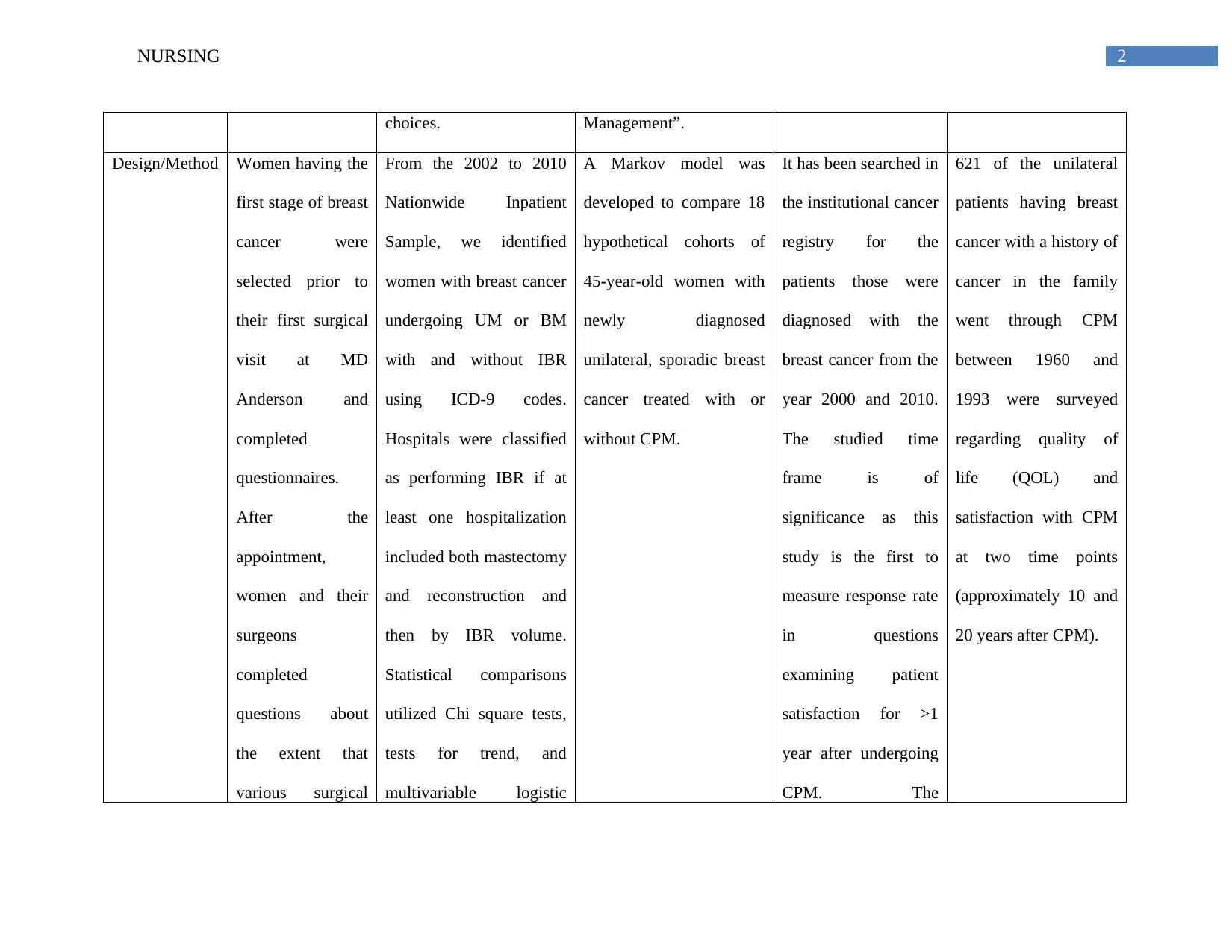
2NURSING
choices. Management”.
Design/Method Women having the
first stage of breast
cancer were
selected prior to
their first surgical
visit at MD
Anderson and
completed
questionnaires.
After the
appointment,
women and their
surgeons
completed
questions about
the extent that
various surgical
From the 2002 to 2010
Nationwide Inpatient
Sample, we identified
women with breast cancer
undergoing UM or BM
with and without IBR
using ICD-9 codes.
Hospitals were classified
as performing IBR if at
least one hospitalization
included both mastectomy
and reconstruction and
then by IBR volume.
Statistical comparisons
utilized Chi square tests,
tests for trend, and
multivariable logistic
A Markov model was
developed to compare 18
hypothetical cohorts of
45-year-old women with
newly diagnosed
unilateral, sporadic breast
cancer treated with or
without CPM.
It has been searched in
the institutional cancer
registry for the
patients those were
diagnosed with the
breast cancer from the
year 2000 and 2010.
The studied time
frame is of
significance as this
study is the first to
measure response rate
in questions
examining patient
satisfaction for >1
year after undergoing
CPM. The
621 of the unilateral
patients having breast
cancer with a history of
cancer in the family
went through CPM
between 1960 and
1993 were surveyed
regarding quality of
life (QOL) and
satisfaction with CPM
at two time points
(approximately 10 and
20 years after CPM).
choices. Management”.
Design/Method Women having the
first stage of breast
cancer were
selected prior to
their first surgical
visit at MD
Anderson and
completed
questionnaires.
After the
appointment,
women and their
surgeons
completed
questions about
the extent that
various surgical
From the 2002 to 2010
Nationwide Inpatient
Sample, we identified
women with breast cancer
undergoing UM or BM
with and without IBR
using ICD-9 codes.
Hospitals were classified
as performing IBR if at
least one hospitalization
included both mastectomy
and reconstruction and
then by IBR volume.
Statistical comparisons
utilized Chi square tests,
tests for trend, and
multivariable logistic
A Markov model was
developed to compare 18
hypothetical cohorts of
45-year-old women with
newly diagnosed
unilateral, sporadic breast
cancer treated with or
without CPM.
It has been searched in
the institutional cancer
registry for the
patients those were
diagnosed with the
breast cancer from the
year 2000 and 2010.
The studied time
frame is of
significance as this
study is the first to
measure response rate
in questions
examining patient
satisfaction for >1
year after undergoing
CPM. The
621 of the unilateral
patients having breast
cancer with a history of
cancer in the family
went through CPM
between 1960 and
1993 were surveyed
regarding quality of
life (QOL) and
satisfaction with CPM
at two time points
(approximately 10 and
20 years after CPM).
⊘ This is a preview!⊘
Do you want full access?
Subscribe today to unlock all pages.

Trusted by 1+ million students worldwide
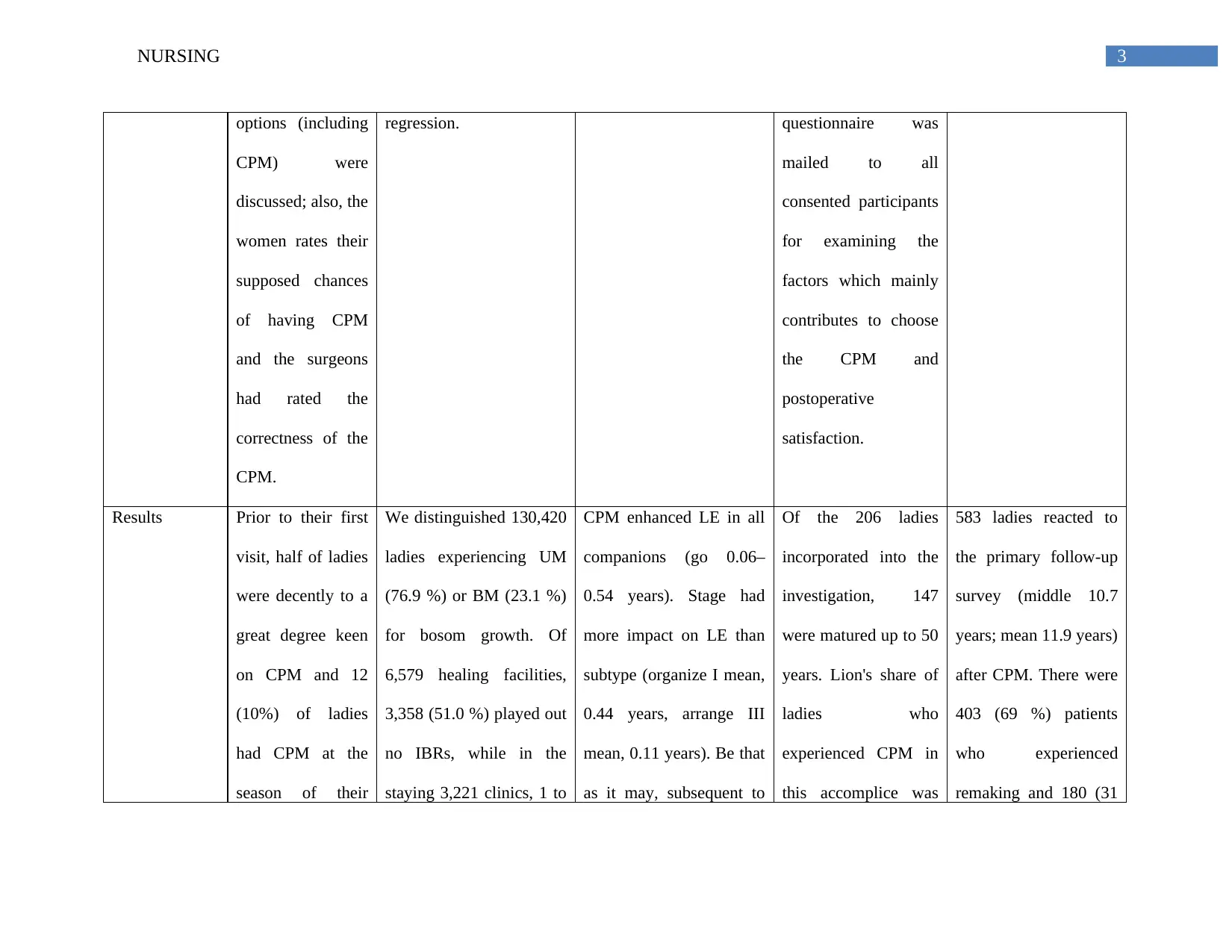
3NURSING
options (including
CPM) were
discussed; also, the
women rates their
supposed chances
of having CPM
and the surgeons
had rated the
correctness of the
CPM.
regression. questionnaire was
mailed to all
consented participants
for examining the
factors which mainly
contributes to choose
the CPM and
postoperative
satisfaction.
Results Prior to their first
visit, half of ladies
were decently to a
great degree keen
on CPM and 12
(10%) of ladies
had CPM at the
season of their
We distinguished 130,420
ladies experiencing UM
(76.9 %) or BM (23.1 %)
for bosom growth. Of
6,579 healing facilities,
3,358 (51.0 %) played out
no IBRs, while in the
staying 3,221 clinics, 1 to
CPM enhanced LE in all
companions (go 0.06–
0.54 years). Stage had
more impact on LE than
subtype (organize I mean,
0.44 years, arrange III
mean, 0.11 years). Be that
as it may, subsequent to
Of the 206 ladies
incorporated into the
investigation, 147
were matured up to 50
years. Lion's share of
ladies who
experienced CPM in
this accomplice was
583 ladies reacted to
the primary follow-up
survey (middle 10.7
years; mean 11.9 years)
after CPM. There were
403 (69 %) patients
who experienced
remaking and 180 (31
options (including
CPM) were
discussed; also, the
women rates their
supposed chances
of having CPM
and the surgeons
had rated the
correctness of the
CPM.
regression. questionnaire was
mailed to all
consented participants
for examining the
factors which mainly
contributes to choose
the CPM and
postoperative
satisfaction.
Results Prior to their first
visit, half of ladies
were decently to a
great degree keen
on CPM and 12
(10%) of ladies
had CPM at the
season of their
We distinguished 130,420
ladies experiencing UM
(76.9 %) or BM (23.1 %)
for bosom growth. Of
6,579 healing facilities,
3,358 (51.0 %) played out
no IBRs, while in the
staying 3,221 clinics, 1 to
CPM enhanced LE in all
companions (go 0.06–
0.54 years). Stage had
more impact on LE than
subtype (organize I mean,
0.44 years, arrange III
mean, 0.11 years). Be that
as it may, subsequent to
Of the 206 ladies
incorporated into the
investigation, 147
were matured up to 50
years. Lion's share of
ladies who
experienced CPM in
this accomplice was
583 ladies reacted to
the primary follow-up
survey (middle 10.7
years; mean 11.9 years)
after CPM. There were
403 (69 %) patients
who experienced
remaking and 180 (31
Paraphrase This Document
Need a fresh take? Get an instant paraphrase of this document with our AI Paraphraser
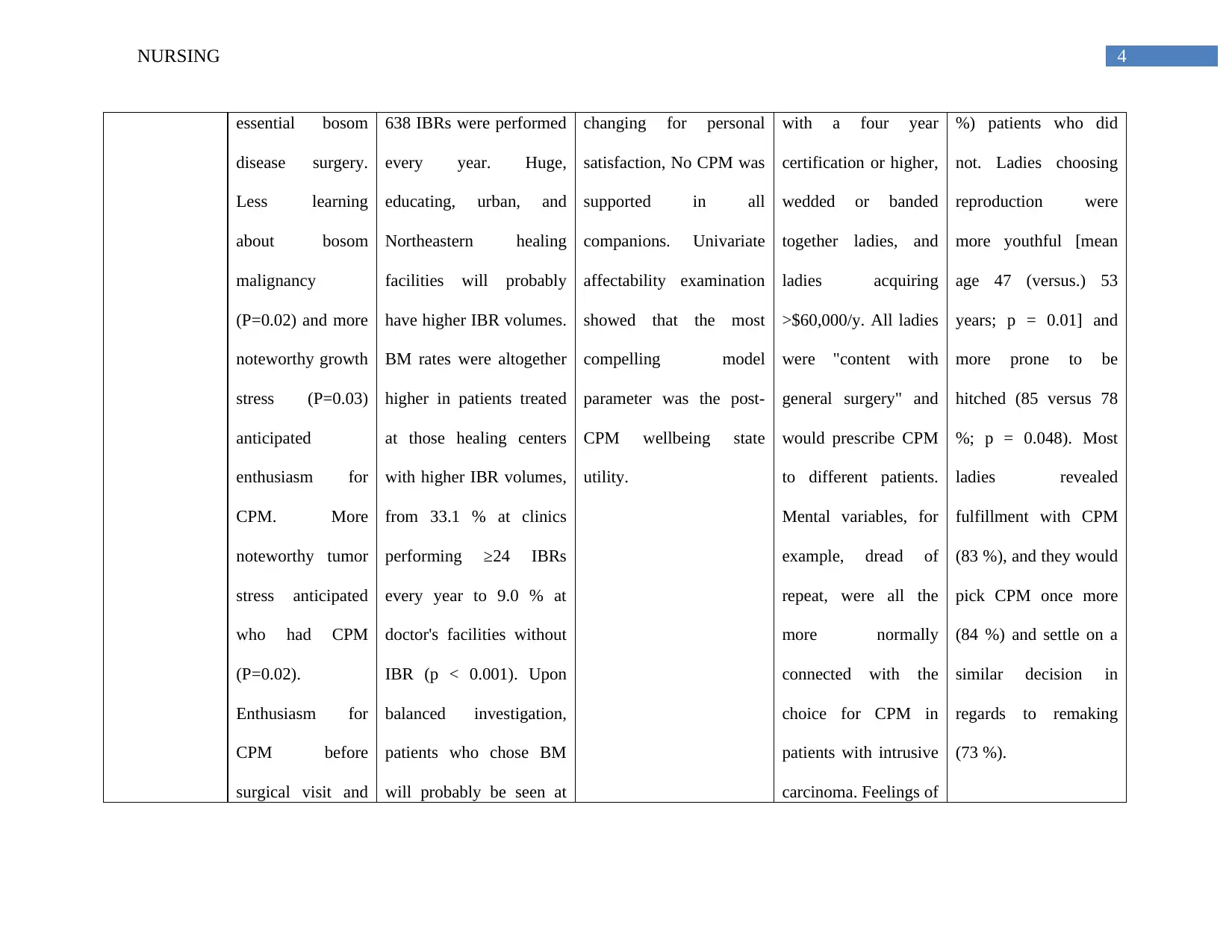
4NURSING
essential bosom
disease surgery.
Less learning
about bosom
malignancy
(P=0.02) and more
noteworthy growth
stress (P=0.03)
anticipated
enthusiasm for
CPM. More
noteworthy tumor
stress anticipated
who had CPM
(P=0.02).
Enthusiasm for
CPM before
surgical visit and
638 IBRs were performed
every year. Huge,
educating, urban, and
Northeastern healing
facilities will probably
have higher IBR volumes.
BM rates were altogether
higher in patients treated
at those healing centers
with higher IBR volumes,
from 33.1 % at clinics
performing ≥24 IBRs
every year to 9.0 % at
doctor's facilities without
IBR (p < 0.001). Upon
balanced investigation,
patients who chose BM
will probably be seen at
changing for personal
satisfaction, No CPM was
supported in all
companions. Univariate
affectability examination
showed that the most
compelling model
parameter was the post-
CPM wellbeing state
utility.
with a four year
certification or higher,
wedded or banded
together ladies, and
ladies acquiring
>$60,000/y. All ladies
were "content with
general surgery" and
would prescribe CPM
to different patients.
Mental variables, for
example, dread of
repeat, were all the
more normally
connected with the
choice for CPM in
patients with intrusive
carcinoma. Feelings of
%) patients who did
not. Ladies choosing
reproduction were
more youthful [mean
age 47 (versus.) 53
years; p = 0.01] and
more prone to be
hitched (85 versus 78
%; p = 0.048). Most
ladies revealed
fulfillment with CPM
(83 %), and they would
pick CPM once more
(84 %) and settle on a
similar decision in
regards to remaking
(73 %).
essential bosom
disease surgery.
Less learning
about bosom
malignancy
(P=0.02) and more
noteworthy growth
stress (P=0.03)
anticipated
enthusiasm for
CPM. More
noteworthy tumor
stress anticipated
who had CPM
(P=0.02).
Enthusiasm for
CPM before
surgical visit and
638 IBRs were performed
every year. Huge,
educating, urban, and
Northeastern healing
facilities will probably
have higher IBR volumes.
BM rates were altogether
higher in patients treated
at those healing centers
with higher IBR volumes,
from 33.1 % at clinics
performing ≥24 IBRs
every year to 9.0 % at
doctor's facilities without
IBR (p < 0.001). Upon
balanced investigation,
patients who chose BM
will probably be seen at
changing for personal
satisfaction, No CPM was
supported in all
companions. Univariate
affectability examination
showed that the most
compelling model
parameter was the post-
CPM wellbeing state
utility.
with a four year
certification or higher,
wedded or banded
together ladies, and
ladies acquiring
>$60,000/y. All ladies
were "content with
general surgery" and
would prescribe CPM
to different patients.
Mental variables, for
example, dread of
repeat, were all the
more normally
connected with the
choice for CPM in
patients with intrusive
carcinoma. Feelings of
%) patients who did
not. Ladies choosing
reproduction were
more youthful [mean
age 47 (versus.) 53
years; p = 0.01] and
more prone to be
hitched (85 versus 78
%; p = 0.048). Most
ladies revealed
fulfillment with CPM
(83 %), and they would
pick CPM once more
(84 %) and settle on a
similar decision in
regards to remaking
(73 %).
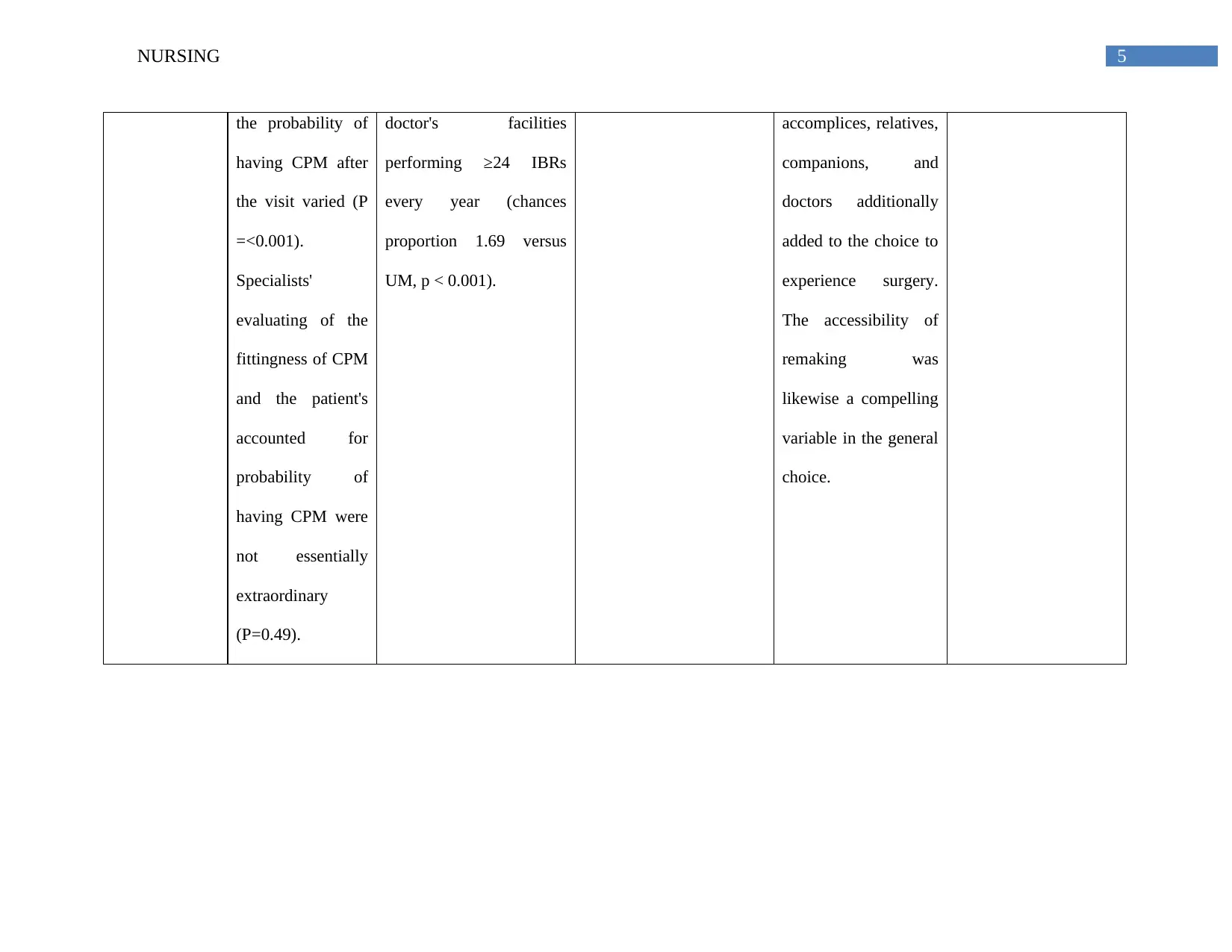
5NURSING
the probability of
having CPM after
the visit varied (P
=<0.001).
Specialists'
evaluating of the
fittingness of CPM
and the patient's
accounted for
probability of
having CPM were
not essentially
extraordinary
(P=0.49).
doctor's facilities
performing ≥24 IBRs
every year (chances
proportion 1.69 versus
UM, p < 0.001).
accomplices, relatives,
companions, and
doctors additionally
added to the choice to
experience surgery.
The accessibility of
remaking was
likewise a compelling
variable in the general
choice.
the probability of
having CPM after
the visit varied (P
=<0.001).
Specialists'
evaluating of the
fittingness of CPM
and the patient's
accounted for
probability of
having CPM were
not essentially
extraordinary
(P=0.49).
doctor's facilities
performing ≥24 IBRs
every year (chances
proportion 1.69 versus
UM, p < 0.001).
accomplices, relatives,
companions, and
doctors additionally
added to the choice to
experience surgery.
The accessibility of
remaking was
likewise a compelling
variable in the general
choice.
⊘ This is a preview!⊘
Do you want full access?
Subscribe today to unlock all pages.

Trusted by 1+ million students worldwide
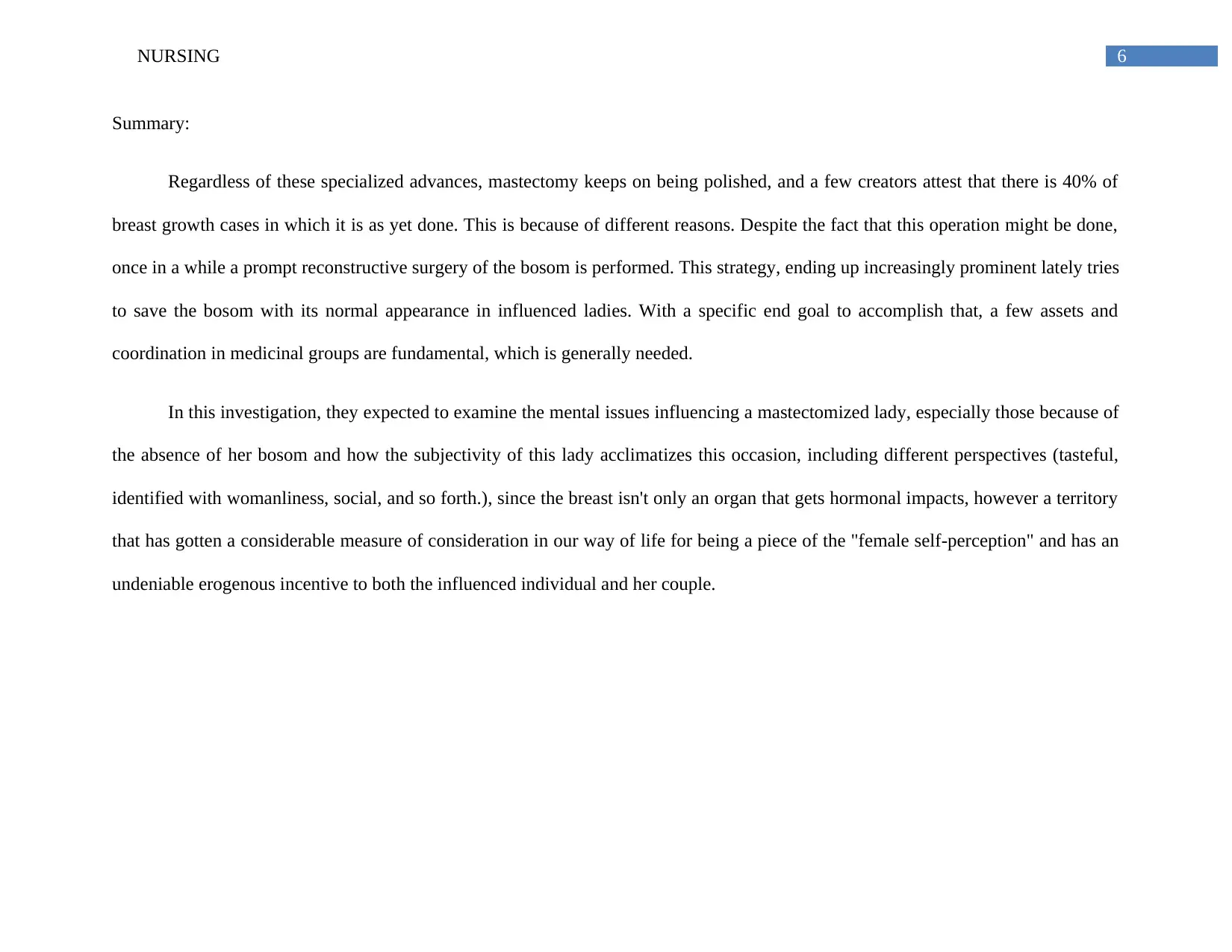
6NURSING
Summary:
Regardless of these specialized advances, mastectomy keeps on being polished, and a few creators attest that there is 40% of
breast growth cases in which it is as yet done. This is because of different reasons. Despite the fact that this operation might be done,
once in a while a prompt reconstructive surgery of the bosom is performed. This strategy, ending up increasingly prominent lately tries
to save the bosom with its normal appearance in influenced ladies. With a specific end goal to accomplish that, a few assets and
coordination in medicinal groups are fundamental, which is generally needed.
In this investigation, they expected to examine the mental issues influencing a mastectomized lady, especially those because of
the absence of her bosom and how the subjectivity of this lady acclimatizes this occasion, including different perspectives (tasteful,
identified with womanliness, social, and so forth.), since the breast isn't only an organ that gets hormonal impacts, however a territory
that has gotten a considerable measure of consideration in our way of life for being a piece of the "female self-perception" and has an
undeniable erogenous incentive to both the influenced individual and her couple.
Summary:
Regardless of these specialized advances, mastectomy keeps on being polished, and a few creators attest that there is 40% of
breast growth cases in which it is as yet done. This is because of different reasons. Despite the fact that this operation might be done,
once in a while a prompt reconstructive surgery of the bosom is performed. This strategy, ending up increasingly prominent lately tries
to save the bosom with its normal appearance in influenced ladies. With a specific end goal to accomplish that, a few assets and
coordination in medicinal groups are fundamental, which is generally needed.
In this investigation, they expected to examine the mental issues influencing a mastectomized lady, especially those because of
the absence of her bosom and how the subjectivity of this lady acclimatizes this occasion, including different perspectives (tasteful,
identified with womanliness, social, and so forth.), since the breast isn't only an organ that gets hormonal impacts, however a territory
that has gotten a considerable measure of consideration in our way of life for being a piece of the "female self-perception" and has an
undeniable erogenous incentive to both the influenced individual and her couple.
Paraphrase This Document
Need a fresh take? Get an instant paraphrase of this document with our AI Paraphraser
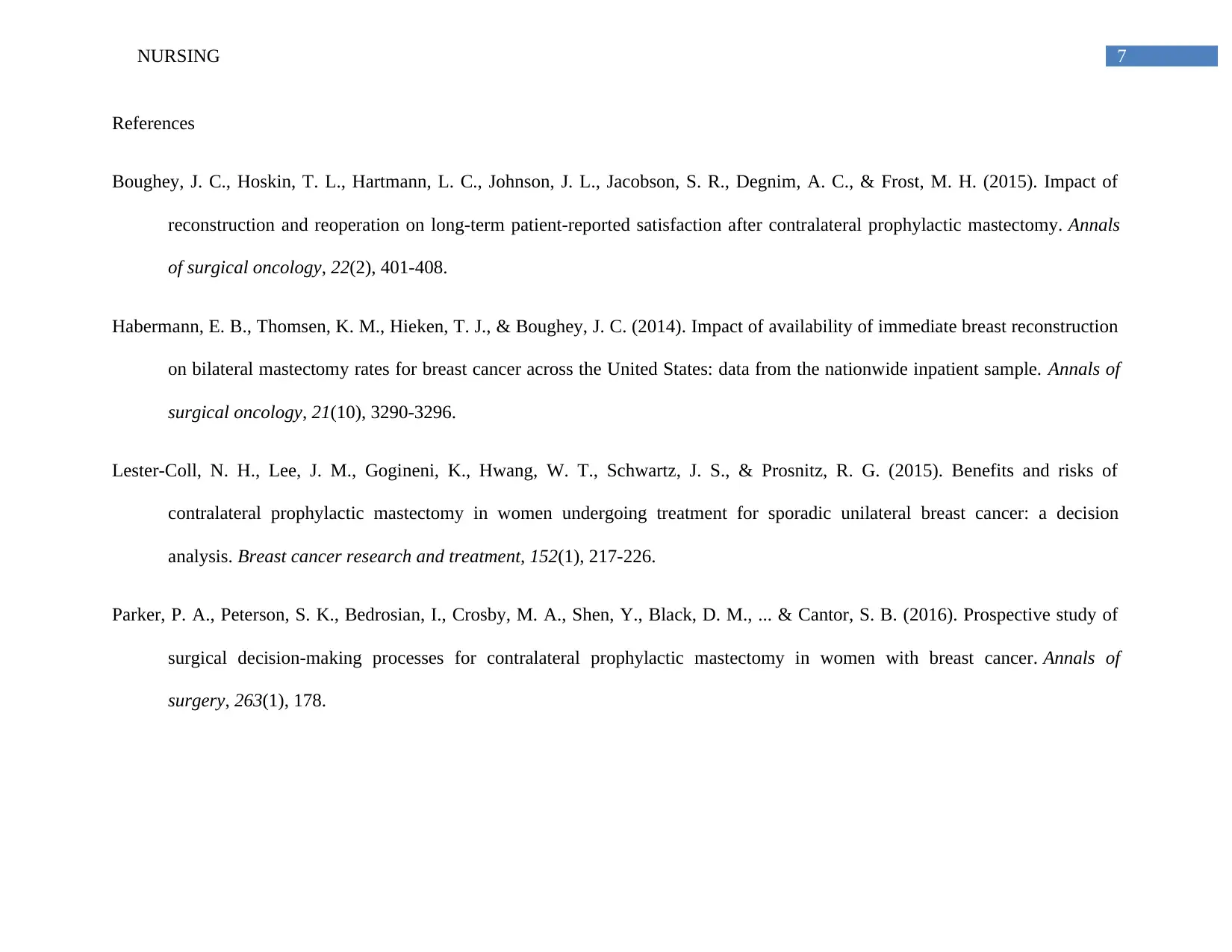
7NURSING
References
Boughey, J. C., Hoskin, T. L., Hartmann, L. C., Johnson, J. L., Jacobson, S. R., Degnim, A. C., & Frost, M. H. (2015). Impact of
reconstruction and reoperation on long-term patient-reported satisfaction after contralateral prophylactic mastectomy. Annals
of surgical oncology, 22(2), 401-408.
Habermann, E. B., Thomsen, K. M., Hieken, T. J., & Boughey, J. C. (2014). Impact of availability of immediate breast reconstruction
on bilateral mastectomy rates for breast cancer across the United States: data from the nationwide inpatient sample. Annals of
surgical oncology, 21(10), 3290-3296.
Lester-Coll, N. H., Lee, J. M., Gogineni, K., Hwang, W. T., Schwartz, J. S., & Prosnitz, R. G. (2015). Benefits and risks of
contralateral prophylactic mastectomy in women undergoing treatment for sporadic unilateral breast cancer: a decision
analysis. Breast cancer research and treatment, 152(1), 217-226.
Parker, P. A., Peterson, S. K., Bedrosian, I., Crosby, M. A., Shen, Y., Black, D. M., ... & Cantor, S. B. (2016). Prospective study of
surgical decision-making processes for contralateral prophylactic mastectomy in women with breast cancer. Annals of
surgery, 263(1), 178.
References
Boughey, J. C., Hoskin, T. L., Hartmann, L. C., Johnson, J. L., Jacobson, S. R., Degnim, A. C., & Frost, M. H. (2015). Impact of
reconstruction and reoperation on long-term patient-reported satisfaction after contralateral prophylactic mastectomy. Annals
of surgical oncology, 22(2), 401-408.
Habermann, E. B., Thomsen, K. M., Hieken, T. J., & Boughey, J. C. (2014). Impact of availability of immediate breast reconstruction
on bilateral mastectomy rates for breast cancer across the United States: data from the nationwide inpatient sample. Annals of
surgical oncology, 21(10), 3290-3296.
Lester-Coll, N. H., Lee, J. M., Gogineni, K., Hwang, W. T., Schwartz, J. S., & Prosnitz, R. G. (2015). Benefits and risks of
contralateral prophylactic mastectomy in women undergoing treatment for sporadic unilateral breast cancer: a decision
analysis. Breast cancer research and treatment, 152(1), 217-226.
Parker, P. A., Peterson, S. K., Bedrosian, I., Crosby, M. A., Shen, Y., Black, D. M., ... & Cantor, S. B. (2016). Prospective study of
surgical decision-making processes for contralateral prophylactic mastectomy in women with breast cancer. Annals of
surgery, 263(1), 178.
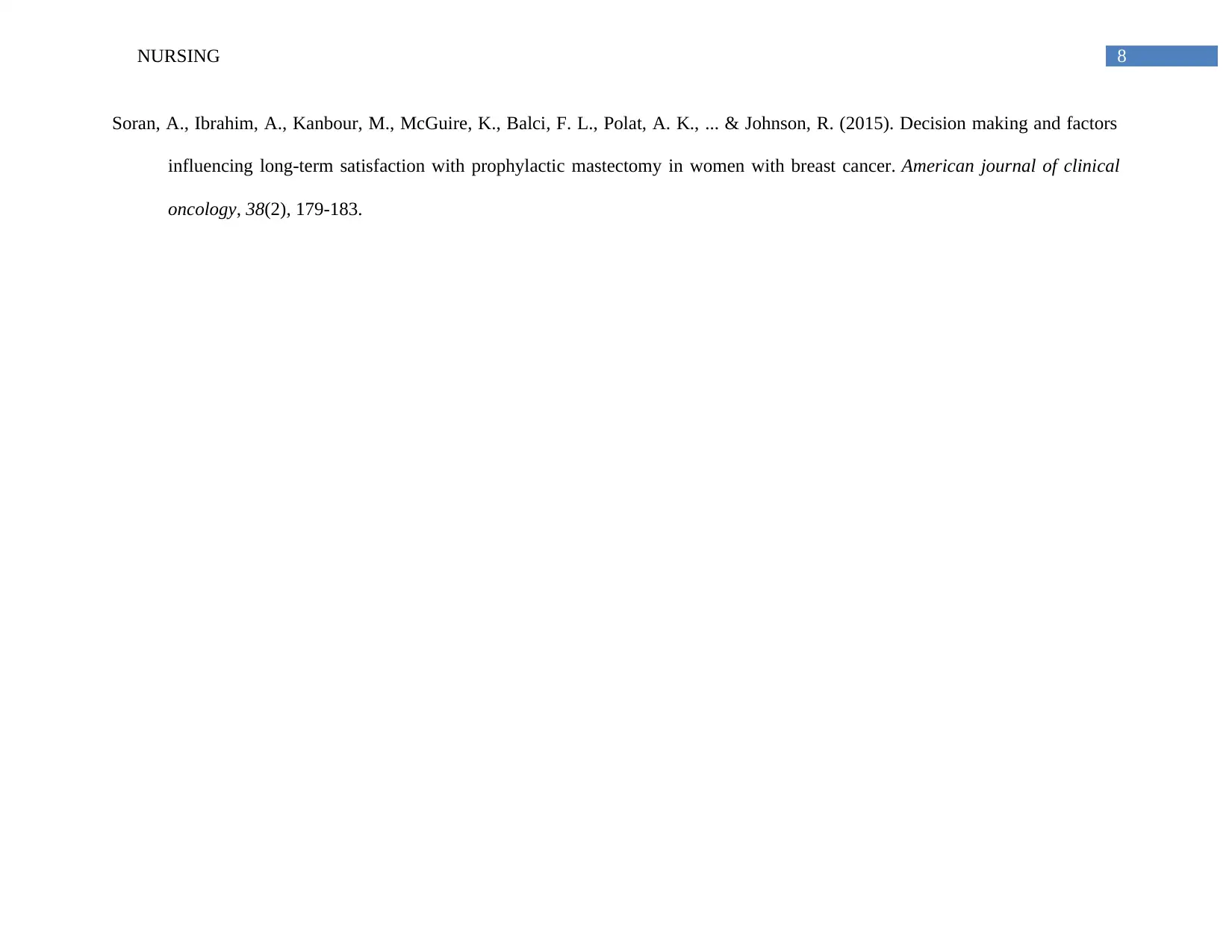
8NURSING
Soran, A., Ibrahim, A., Kanbour, M., McGuire, K., Balci, F. L., Polat, A. K., ... & Johnson, R. (2015). Decision making and factors
influencing long-term satisfaction with prophylactic mastectomy in women with breast cancer. American journal of clinical
oncology, 38(2), 179-183.
Soran, A., Ibrahim, A., Kanbour, M., McGuire, K., Balci, F. L., Polat, A. K., ... & Johnson, R. (2015). Decision making and factors
influencing long-term satisfaction with prophylactic mastectomy in women with breast cancer. American journal of clinical
oncology, 38(2), 179-183.
⊘ This is a preview!⊘
Do you want full access?
Subscribe today to unlock all pages.

Trusted by 1+ million students worldwide
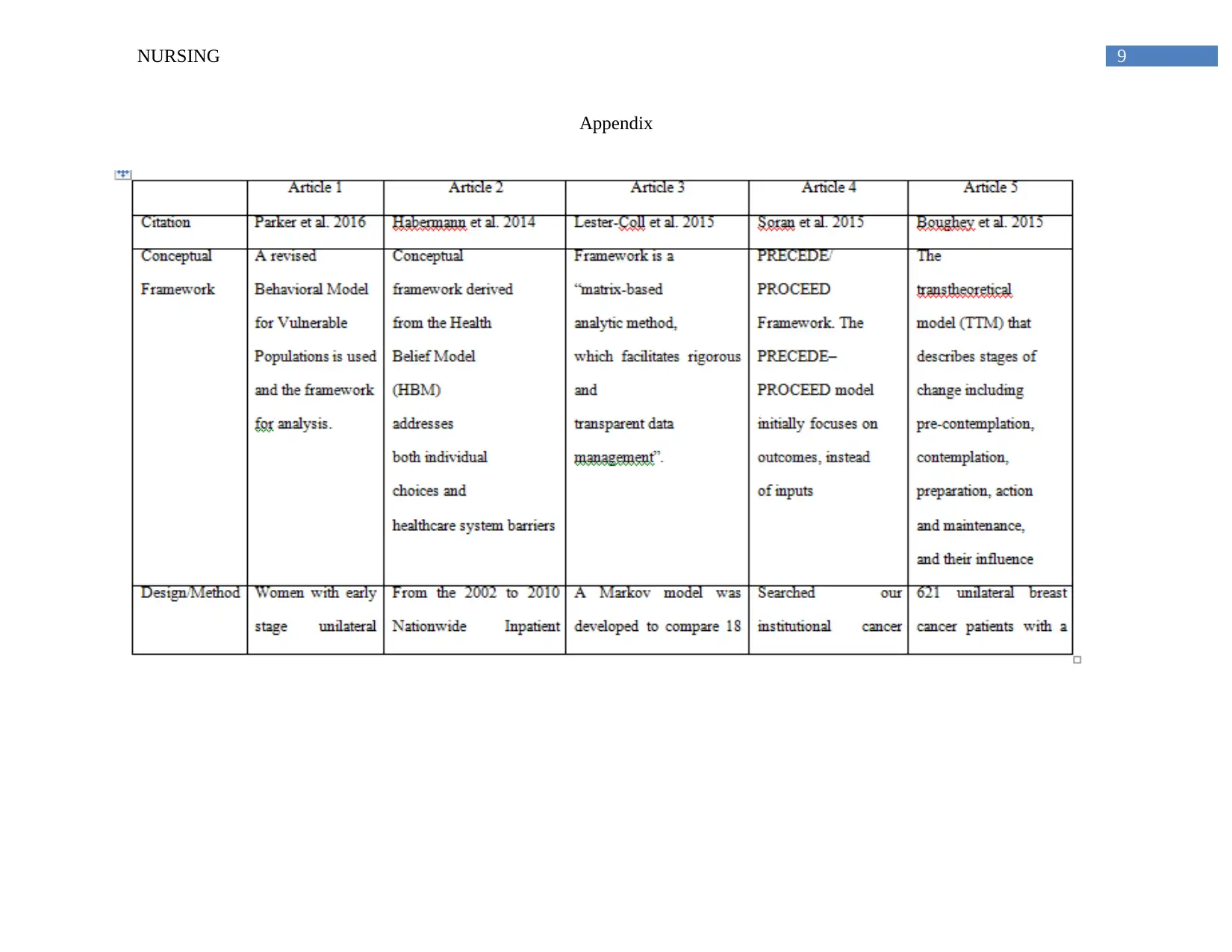
9NURSING
Appendix
Appendix
Paraphrase This Document
Need a fresh take? Get an instant paraphrase of this document with our AI Paraphraser
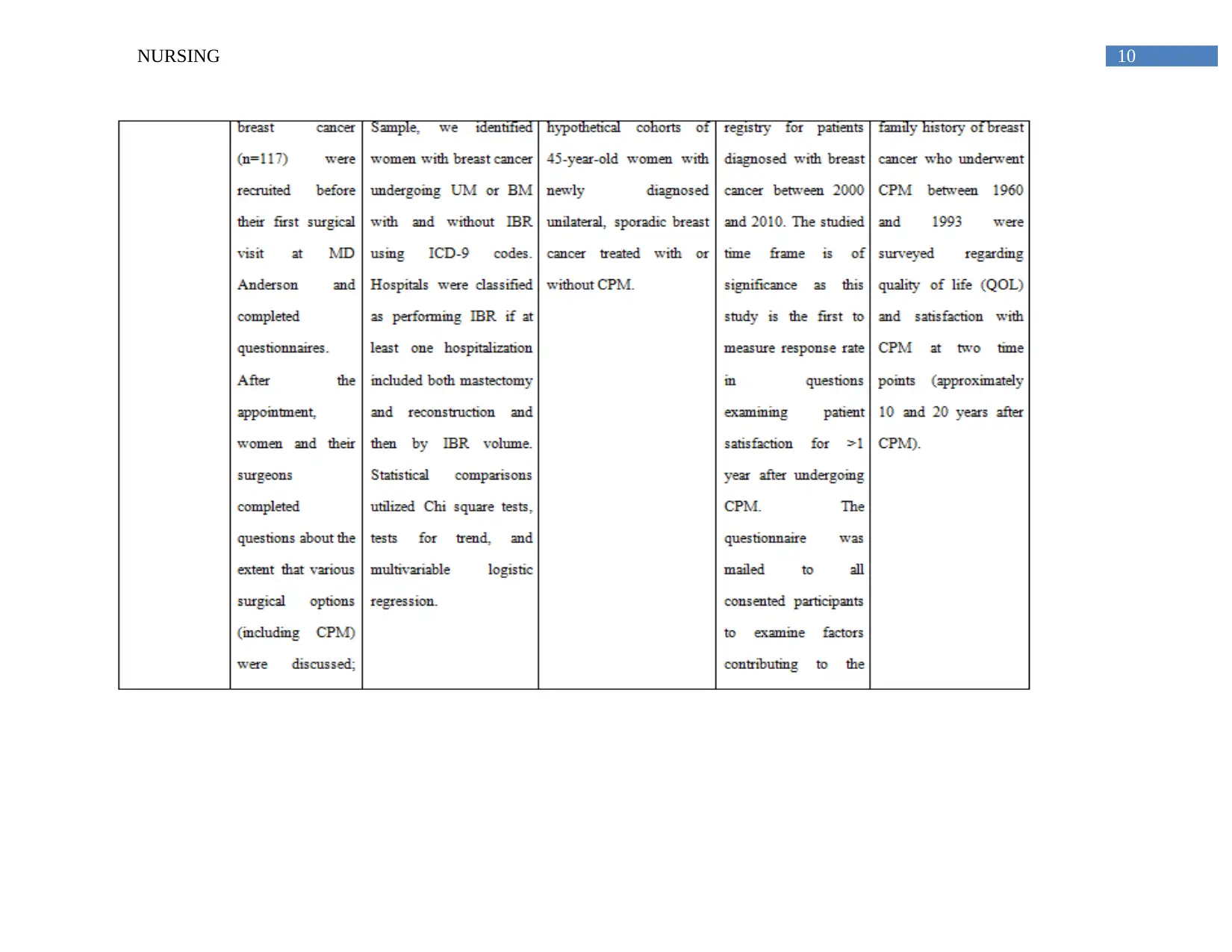
10NURSING
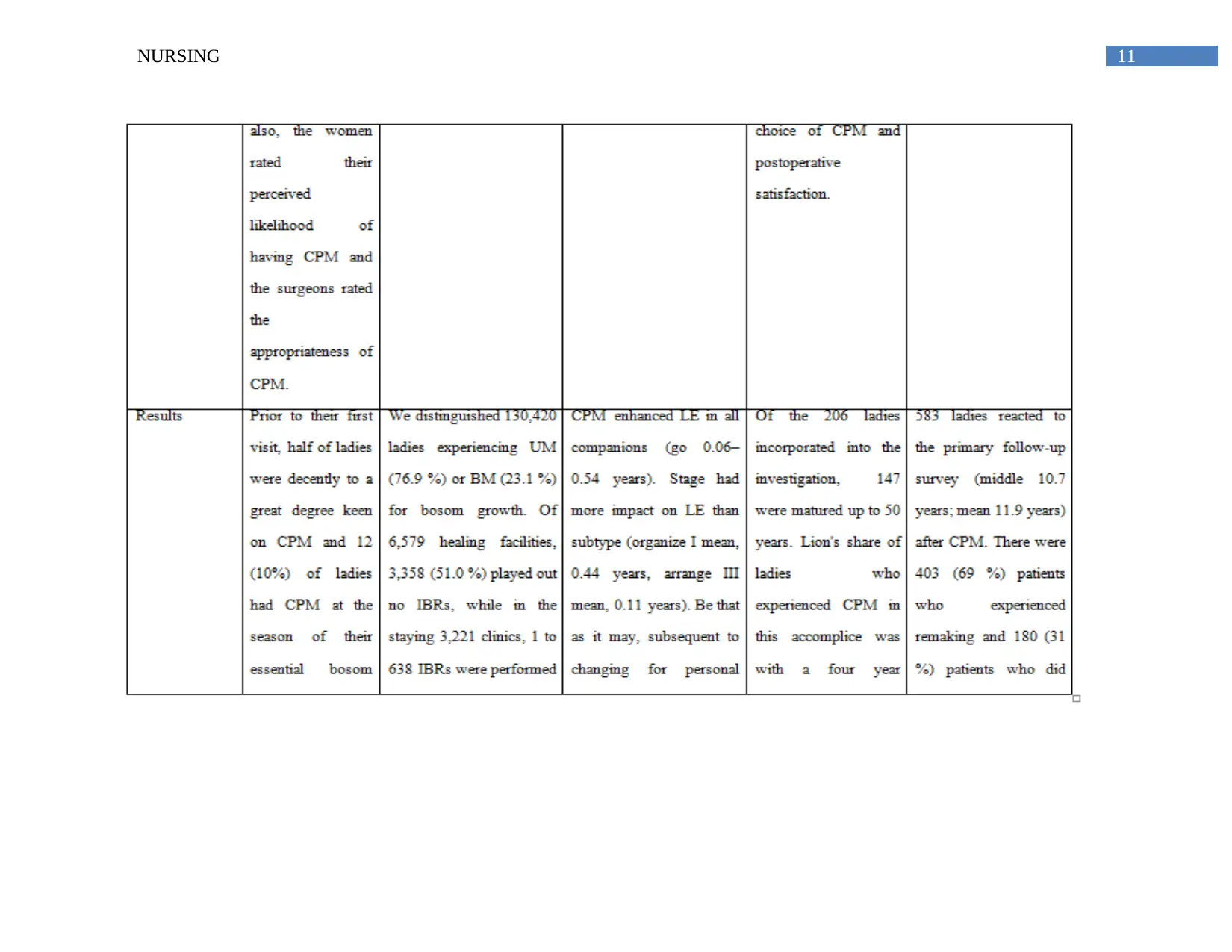
11NURSING
⊘ This is a preview!⊘
Do you want full access?
Subscribe today to unlock all pages.

Trusted by 1+ million students worldwide
1 out of 12
Related Documents
Your All-in-One AI-Powered Toolkit for Academic Success.
+13062052269
info@desklib.com
Available 24*7 on WhatsApp / Email
![[object Object]](/_next/static/media/star-bottom.7253800d.svg)
Unlock your academic potential
Copyright © 2020–2025 A2Z Services. All Rights Reserved. Developed and managed by ZUCOL.





